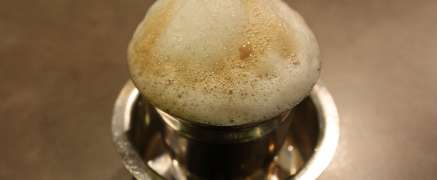The tea country India, with a market share of 3 %, ranks #6 among the coffee exporters and has great traditional recipes like kaapi.
- The Indian Sufi Baba Budan is said to have smuggled 7 coffee beans from Mocha in Yemen to India in the 17th century from a pilgrimage to Mecca.
- The best cultivation areas are in the south of India, where the climate is characterized by the tropical monsoon.
- The states of Karnataka, Kerala and Tamil Nadu are called the coffee belt.
- A very special cultivation area worldwide is the Malzbar region, since coffee seldom is cultivated as here on the coast at over 1,000 m altitude.
- Cultivated are 40 % Arabica and 60 % Robusta beans.
- Indian coffee has little acidity and is thus particularly gentle on the stomach.
- Balanced in taste, with a spicy, powerful body.
- Monsooning is a preparation method that goes back to times when the coffee was shipped to Europe for about 6 months and exposed to high humidity in the sea. Since the coffee is thus given a particularly spicy, powerful body, the method is imitated today. After the harvest, the raw coffee is exposed to rain and monsoon winds for weeks in open storage houses. It is then stored in bags and hand-picked.
- The Coffee Board of India organization aims to promote coffee production, sales and consumption in India, to carry out general coffee research and to provide financial assistance to small coffee farmers, including securing working conditions on plantations and sustainability.
- How to prepare this great coffee traditionally Indian, like kaapi, read below!
Advertisment
Traditional Preparation – Kaapi and more
Kaapi / Madras filter coffee
- South Indian filter coffee specialty
- 70-80% medium-roasted and finely ground beans are mixed with 20-30% roasted chicory*.
- A metal filter, similar to the Vietnamese phin, is used for the preparation of kaapi.
- In the lower part of the filter comes the coffee mixture. Then the filter is put together, so that the coffee is compressed.
- Pour boiling water into the upper part of the filter, which then slowly drips through the coffee powder.
- The Kaapi is very strong. Therefore, only 1-2 tbsp. of the filter coffee is added to a cup of boiling milk and sweetened with sugar as required.
- Shake until frothy and serve in a typical stainless steel cup with saucer (Tumbler & Dabarah)
- The cup is used to cool the Kaapi by pouring back and forth
Indian Masala coffee
- Add 500 ml milk with 250 ml of water and 5 tbsp brown sugar into a pot.
- Cut 6 cardamom* seeds and press inner black grains.
- Add the cardamom* seeds with 1 cinnamon stick* to the milk mixture and slowly boil, then simmer 3 min. over medium heat.
- Add 4 tbsp of coarse ground coffee into the pot and simmer another 3 min.
- Drain the coffee through a fine sieve and distribute it in 4 glasses. Finally shake vigorously, so that the coffee becomes beautifully frothy.
Phenti Hui – beaten or whipped coffee
- Beat 2-3 tbsp instant coffee*, 2-3 tbsp sugar*, 1 tbsp cold water until it is creamy and fluffy foam
- Add some of the coffee foam to a glass and fill up with cold or hot milk.
- Stir and add another tbsp of coffee foam on top.
For advertising links on this page the dealer may pay a commission. These advertising links are marked with an asterisk (*) – images and banners are marked with “Ads” or “Advertisment”. There are no costs for you. Find more information in the data protection regulations here.








